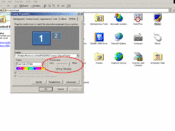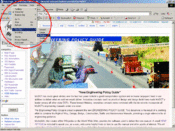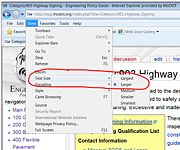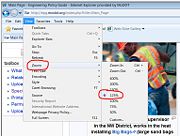Help Article: Difference between revisions
mNo edit summary |
|||
| Line 6: | Line 6: | ||
|} | |} | ||
The Engineering Policy Guide (EPG) contains MoDOT policy, procedure and guidance for the planning, design, construction and maintenance of roadway and related facilities. It also includes specific technical topics of right of way, bridge, traffic and materials. | The Engineering Policy Guide (EPG) contains MoDOT policy, procedure and guidance for the planning, design, construction and maintenance of roadway and related facilities. It also includes specific technical topics of right of way, bridge, traffic and materials. These articles are numbered to reflect as closely as possible the pay items and divisions from ''Missouri Standard Specifications for Highway Construction''. | ||
The EPG is not a contract document and EPG articles are referenced as EPG XXX.X or "articles" - not "sections" - to avoid confusion with MoDOT | The EPG is not a contract document and EPG articles are referenced as EPG XXX.X or "articles" - not "sections" - to avoid confusion with MoDOT specifications. Where a conflict exists between the EPG and a contract, the contract document rules. References and links to the ''Missouri Standard Specifications'' are given as "Sec XXX.XX" or "Section XXX.XX of the Standard Specifications." References and links to the ''Missouri Standard Plans for Highway Construction'' are "Standard Plan XXX.XX". | ||
==Organization== | |||
Articles are grouped into the specification book’s divisions (for example, the EPG articles in [[:Category:100 GENERAL|EPG 100 General]] mirror Division 100 specifications, articles in [[:Category:300 BASES|EPG 300 Bases]] mirror Division 300 specifications, etc.). Many articles have been subdivided into additional articles. For example, the reader may notice that [[903.6 Warning Signs|EPG 903.6 Warning Signs]] and other EPG 903 articles are listed at the bottom of [[:Category:903 Highway Signing|EPG 903 Highway Signing]]. | |||
While every effort has been made to base the article numbers on MoDOT pay items and | While every effort has been made to base the article numbers on MoDOT pay items and specifications, not all articles in the EPG are reflected in the pay items and specifications. For example, many EPG “100 General” articles are important to the design and construction of roadway facilities but do not directly correspond to specific pay items. Some of these are: | ||
* [[:category:121 Project Planning, Prioritization and STIP Commitments|EPG 121 Project Planning, Prioritization and STIP Commitments]] | * [[:category:121 Project Planning, Prioritization and STIP Commitments|EPG 121 Project Planning, Prioritization and STIP Commitments]] | ||
| Line 29: | Line 23: | ||
* [[:Category:132 Safety|EPG 132 Safety]] | * [[:Category:132 Safety|EPG 132 Safety]] | ||
Similar examples are to be found in the EPG 200, EPG 300, etc. articles. | Similar examples are to be found in the EPG 200, EPG 300, etc. articles. | ||
==How best to view the articles== | |||
The articles are best viewed on your computer monitor with the following settings: | The articles are best viewed on your computer monitor with the following settings: | ||
| Line 48: | Line 40: | ||
|} | |} | ||
==How to Easily Select and Print an Entire Article or a Portion of an Article== | |||
:'''1)''' Highlight the selected article or portion of article | :'''1)''' Highlight the selected article or portion of article | ||
[[image:Help Article Print 1.jpg|center| | [[image:Help Article Print 1.jpg|center|600px]] | ||
:'''2)''' Click “File” | :'''2)''' Click “File” | ||
[[image:Help Article Print 2.jpg|center| | [[image:Help Article Print 2.jpg|center|440px]] | ||
:'''3)''' Click “Print Preview” | :'''3)''' Click “Print Preview” | ||
[[image:Help Article Print 3.jpg|center| | [[image:Help Article Print 3.jpg|center|400px]] | ||
:'''4)''' Select “As selected on screen” | :'''4)''' Select “As selected on screen” | ||
[[image:Help Article Print 4.jpg|center| | [[image:Help Article Print 4.jpg|center|630px]] | ||
:'''5)''' Should your selection include a large table or figure that creates an undesirable appearance, you may want to click the “Shrink To Fit” tab and perhaps select “85%”. | :'''5)''' Should your selection include a large table or figure that creates an undesirable appearance, you may want to click the “Shrink To Fit” tab and perhaps select “85%”. | ||
| Line 66: | Line 58: | ||
:'''6)''' Print the selection. | :'''6)''' Print the selection. | ||
== | [[image:Help Article Request Form title.jpg|right|350px]] | ||
==EPG Approval Process== | |||
Revisions to engineering policy are proposed using the [http://sharepoint/sites/de/epg/Lists/EPGResponse/Item/newifs.aspx?List=8224cbb0%2D2570%2D419a%2Da4a0%2D4eb7416e97d3&RootFolder=&Web=c952a564%2D1467%2D40b5%2Da053%2D422131a2ca38 Engineering Policy Revision Request Form]. Revisions to forms used in the EPG are also proposed by using the Engineering Policy Revision Request Form. | |||
'''Any other standard affected by a proposed EPG revision?''' | |||
Provide electronic files of all the revisions to other MoDOT standards (other EPG articles, any Standard Plans, specifications, JSPs, etc.) impacted by the EPG proposal. Word files in revision mode are required for textual changes. Dgn files are preferred for Standard Plan revisions although a redlined hard copy showing the proposed changes is also acceptable. | |||
[[image:Help Article Request Form Issue Name.jpg|right|350px]] | |||
===Completing the Engineering Policy Revision Request Form=== | |||
Every submittal must document, along with the actual proposed textual revision to the EPG: | Every submittal must document, along with the actual proposed textual revision to the EPG: | ||
:''' | :'''Contact.''' The name of the sponsor from within the division proposing the revision is required. The contact is the person most knowledgeable or central to the proposal. | ||
:''' | :'''Summarize.''' Provide the reason why the idea should be carried out (why it is necessary or its benefit). This justification may be critical in the decision to approve the proposal or not. | ||
:''' | :'''Fiscal Impact.''' Provide a dollar estimate for the proposal’s costs or savings to MoDOT. Include necessary calculations (initial savings or life cycle savings, for example) or assertions to accurately convey the proposal’s financial impact. The fiscal impact must be a numeric dollar value. | ||
The Engineering Policy Revision Request Form also requires the '''date''', '''issue name''' and a '''listing of all affected publications'''. (For instance, should a proposal for EPG 606.1 also require revisions to Sec 606 and Std. Plan 606.30, the section and standard plan as well as their proposed revisions would be specified along with the proposed revisions to the EPG article.) | |||
It is optional to enter the proposal's '''external involvement.''' Provide a summary of any efforts undertaken during the development of the item to engage affected industry groups and the FHWA. Provide specific examples of who was involved and how the involvement occurred. This is not applicable to every submittal, but is critical for the determination of the associated approval level for borderline items. | |||
Proposed revisions will be categorized by the Policy and Innovations Engineer based on the following guidelines: | It is also optional to enter information about whether the proposal involves an '''Administrative Rule''' or '''LPA''' guidance, the submitter's '''tracking number''' (if any) and the submitter's '''desired effective letting date'''. | ||
===After the proposed EPG revision is submitted=== | |||
Submittals are evaluated and processed on a quarterly schedule. Final decisions on proposed ballots are submitted to the Policy and Innovations Engineer for disposition. The Assistant Chief Engineer submits the final decision on Level 2 revisions and the Chief Engineer submits the final decision on Level 3 revisions. Proposed revisions will be categorized by the Policy and Innovations Engineer based on the following guidelines: | |||
<div id="Level 1 Approval"></div> | <div id="Level 1 Approval"></div> | ||
| Line 124: | Line 108: | ||
|'''High/Tall:''' Use “high” to express a lofty position, such as the clouds are high. Use “tall” to express a great vertical dimension, such as the tall post. | |'''High/Tall:''' Use “high” to express a lofty position, such as the clouds are high. Use “tall” to express a great vertical dimension, such as the tall post. | ||
|- | |- | ||
| | |'''Until:''' Do not use "til". | ||
|} | |} | ||
'''Level 2 Approval.''' If, upon submittal in the Engineering Policy Revision Request Form, a proposed revision is determined to be a moderate technical change, if it requires specific expertise (e.g. structural design, etc.) or if it impacts more than one division, the proposal is processed as a Level 2 Ballot item. The District Engineers and | '''Level 2 Approval.''' If, upon submittal in the Engineering Policy Revision Request Form, a proposed revision is determined to be a moderate technical change, if it requires specific expertise (e.g. structural design, etc.) or if it impacts more than one division, the proposal is processed as a Level 2 Ballot item. The District Engineers and Division Directors/Engineers are provided 10 business days to provide their comments to the Assistant Chief Engineer who will consider the idea before providing a decision to the Policy and Innovations Engineer. The Federal Highway Administration is given 10 working days to provide comment or concurrence with the Policy and Innovations Engineer. Upon approval any associated documents and the EPG will be revised as necessary. | ||
'''Level 3 Approval.''' If, upon submittal in the Engineering Policy Revision Request Form, a proposed revision is determined to be a complex technical change, contentious, has high cost or impacts MoDOT's external conduct of business, the proposal is processed as a Level 3 Ballot item. The District Engineers and select Division Directors/Engineers are provided | '''Level 3 Approval.''' If, upon submittal in the Engineering Policy Revision Request Form, a proposed revision is determined to be a complex technical change, contentious, has high cost or impacts MoDOT's external conduct of business, the proposal is processed as a Level 3 Ballot item. The District Engineers and select Division Directors/Engineers are provided 10 business days to provide their comments to the Chief Engineer who will consider the idea before providing their decision to the Policy and Innovations Engineer. The Federal Highway Administration is provided 10 business days to provide comment or concur with the proposal. Upon approval, any associated documents and the EPG will be revised as necessary. | ||
Changes to the Standard Specification, Standard Drawings, Pay Items and significant changes to JSPs are documented by [https://spexternal.modot.mo.gov/sites/de/DSL/Forms/ByYear.aspx Design Standards Letters] and posted both internally and externally | Changes to the Standard Specification, Standard Drawings, Pay Items and significant changes to JSPs are documented by [https://spexternal.modot.mo.gov/sites/de/DSL/Forms/ByYear.aspx Design Standards Letters] and posted both internally and externally. | ||
===EPG Ballot Cycles=== | |||
<font size : 20%><font color = "white">.</font color = "white"> | |||
{|style="padding: 0.3em; margin-right:20px; border:2px solid #a9a9a9; text-align:center; font-size: 95%; background:#f5f5f5" width="965x" align="center" | {|style="padding: 0.3em; margin-right:20px; border:2px solid #a9a9a9; text-align:center; font-size: 95%; background:#f5f5f5" width="965x" align="center" | ||
|- | |- | ||
| Line 152: | Line 137: | ||
|} | |} | ||
==Division Contacts== | |||
Since the divisions provide authoritative input, consulting with their liaisons or contacts may provide the help you require or receive your input. Below is a listing of divisional personnel with whom the Engineering Policy staff works and who may be helpful to you: | Since the divisions provide authoritative input, consulting with their liaisons or contacts may provide the help you require or receive your input. Below is a listing of divisional personnel with whom the Engineering Policy staff works and who may be helpful to you: | ||
| Line 169: | Line 146: | ||
::'''''Construction and Materials:''''' | ::'''''Construction and Materials:''''' | ||
:::Chemical Laboratory: Todd Bennett | :::Chemical Laboratory: Todd Bennett | ||
:::Construction Engineering: Dennis Brucks, Randy Hitt | :::Construction Engineering: Dennis Brucks, Randy Hitt | ||
| Line 177: | Line 154: | ||
:::Physical Laboratory: Brett Trautman | :::Physical Laboratory: Brett Trautman | ||
::'''''Design:''''' | ::'''''Design:''''' Brandi Baldwin, Troy Hughes, Tim Schroeder, Dave Simmons | ||
:::Bid & Contract Services: Llans Taylor | |||
:::CADD Services: Steve Adkinson | |||
:::Environmental & Historic Preservation: Mike Meinkoth | :::Environmental & Historic Preservation: Mike Meinkoth | ||
:::LPA: Laura Ellen | |||
:::Right of Way: Mendy Sundermeyer, Greg Wood | :::Right of Way: Mendy Sundermeyer, Greg Wood | ||
| Line 191: | Line 174: | ||
::'''''Maintenance:''''' Tim Jackson | ::'''''Maintenance:''''' Tim Jackson | ||
::''''' | ::'''''Multimodal:''''' Michelle Kratzer | ||
:::Aviation: Amy Ludwig | |||
:: | :::Freight & Waterways: Cheryl Ball | ||
:::Railroads: Eric Curtit | |||
:::Transit: Joni Roeseler | |||
::'''''Planning:''''' Machelle Watkins | ::'''''Planning:''''' Machelle Watkins | ||
Revision as of 11:25, 17 June 2019
| Engineering Policy Revision Request Form |
| Form to Propose Level 1, 2 and 3 Revisions for the EPG and other MoDOT Standards |
The Engineering Policy Guide (EPG) contains MoDOT policy, procedure and guidance for the planning, design, construction and maintenance of roadway and related facilities. It also includes specific technical topics of right of way, bridge, traffic and materials. These articles are numbered to reflect as closely as possible the pay items and divisions from Missouri Standard Specifications for Highway Construction.
The EPG is not a contract document and EPG articles are referenced as EPG XXX.X or "articles" - not "sections" - to avoid confusion with MoDOT specifications. Where a conflict exists between the EPG and a contract, the contract document rules. References and links to the Missouri Standard Specifications are given as "Sec XXX.XX" or "Section XXX.XX of the Standard Specifications." References and links to the Missouri Standard Plans for Highway Construction are "Standard Plan XXX.XX".
Organization
Articles are grouped into the specification book’s divisions (for example, the EPG articles in EPG 100 General mirror Division 100 specifications, articles in EPG 300 Bases mirror Division 300 specifications, etc.). Many articles have been subdivided into additional articles. For example, the reader may notice that EPG 903.6 Warning Signs and other EPG 903 articles are listed at the bottom of EPG 903 Highway Signing.
While every effort has been made to base the article numbers on MoDOT pay items and specifications, not all articles in the EPG are reflected in the pay items and specifications. For example, many EPG “100 General” articles are important to the design and construction of roadway facilities but do not directly correspond to specific pay items. Some of these are:
Similar examples are to be found in the EPG 200, EPG 300, etc. articles.
How best to view the articles
The articles are best viewed on your computer monitor with the following settings:
How to Easily Select and Print an Entire Article or a Portion of an Article
- 1) Highlight the selected article or portion of article
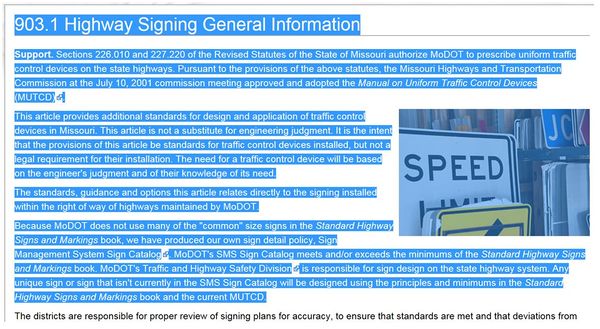
- 2) Click “File”
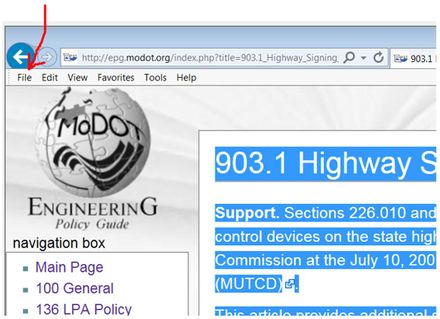
- 3) Click “Print Preview”
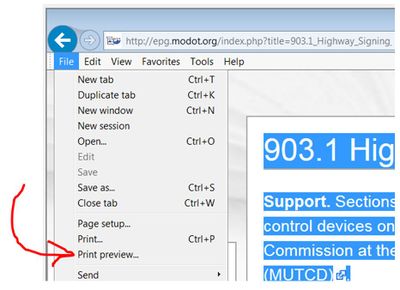
- 4) Select “As selected on screen”

- 5) Should your selection include a large table or figure that creates an undesirable appearance, you may want to click the “Shrink To Fit” tab and perhaps select “85%”.
- 6) Print the selection.

EPG Approval Process
Revisions to engineering policy are proposed using the Engineering Policy Revision Request Form. Revisions to forms used in the EPG are also proposed by using the Engineering Policy Revision Request Form.
Any other standard affected by a proposed EPG revision?
Provide electronic files of all the revisions to other MoDOT standards (other EPG articles, any Standard Plans, specifications, JSPs, etc.) impacted by the EPG proposal. Word files in revision mode are required for textual changes. Dgn files are preferred for Standard Plan revisions although a redlined hard copy showing the proposed changes is also acceptable.
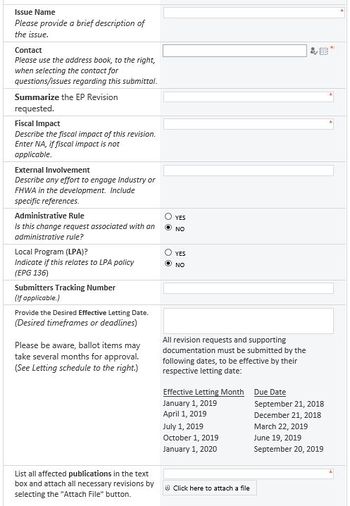
Completing the Engineering Policy Revision Request Form
Every submittal must document, along with the actual proposed textual revision to the EPG:
- Contact. The name of the sponsor from within the division proposing the revision is required. The contact is the person most knowledgeable or central to the proposal.
- Summarize. Provide the reason why the idea should be carried out (why it is necessary or its benefit). This justification may be critical in the decision to approve the proposal or not.
- Fiscal Impact. Provide a dollar estimate for the proposal’s costs or savings to MoDOT. Include necessary calculations (initial savings or life cycle savings, for example) or assertions to accurately convey the proposal’s financial impact. The fiscal impact must be a numeric dollar value.
The Engineering Policy Revision Request Form also requires the date, issue name and a listing of all affected publications. (For instance, should a proposal for EPG 606.1 also require revisions to Sec 606 and Std. Plan 606.30, the section and standard plan as well as their proposed revisions would be specified along with the proposed revisions to the EPG article.)
It is optional to enter the proposal's external involvement. Provide a summary of any efforts undertaken during the development of the item to engage affected industry groups and the FHWA. Provide specific examples of who was involved and how the involvement occurred. This is not applicable to every submittal, but is critical for the determination of the associated approval level for borderline items.
It is also optional to enter information about whether the proposal involves an Administrative Rule or LPA guidance, the submitter's tracking number (if any) and the submitter's desired effective letting date.
After the proposed EPG revision is submitted
Submittals are evaluated and processed on a quarterly schedule. Final decisions on proposed ballots are submitted to the Policy and Innovations Engineer for disposition. The Assistant Chief Engineer submits the final decision on Level 2 revisions and the Chief Engineer submits the final decision on Level 3 revisions. Proposed revisions will be categorized by the Policy and Innovations Engineer based on the following guidelines:
Level 1 Approval. If, upon submittal in the Engineering Policy Revision Request Form, a proposed revision is determined to be a routine technical matter, an errata correction or a clarification, it can be approved by the Policy and Innovations Engineer without comment from the district engineers, the division engineers or the Chief Engineer. The EPG will be revised as necessary.
| Tips on Text |
| While Engineering Policy Services edits all submittals, a few grammatical guidelines for the EPG include: |
| Assure/Ensure/Insure: The word “assure” is a personal guarantee based on reputation. “Ensure” is used when the party is to make certain of something or to be careful. “Insure” refers to actions protected by insurance, and indicates that money is involved. |
| Dimensions: Typically use “high”, “wide” and “long” instead of “in height”, “in width” and “in length”. |
| Farther/Further: Use “farther” to express a physical distance, such as 10 miles farther, and “further” for a non-physical dimension, such as further thought. |
| Fewer/less: Use “few” or “fewer” for something comprised of a small number of countable components (such as fewer dollars, fewer gallons of water, etc.). Use “less” for amounts that are not being counted (less money, less water, etc.). |
| Gender: Minimize the use of “he/she”, “he and she” and “she or he”. |
| High/Tall: Use “high” to express a lofty position, such as the clouds are high. Use “tall” to express a great vertical dimension, such as the tall post. |
| Until: Do not use "til". |
Level 2 Approval. If, upon submittal in the Engineering Policy Revision Request Form, a proposed revision is determined to be a moderate technical change, if it requires specific expertise (e.g. structural design, etc.) or if it impacts more than one division, the proposal is processed as a Level 2 Ballot item. The District Engineers and Division Directors/Engineers are provided 10 business days to provide their comments to the Assistant Chief Engineer who will consider the idea before providing a decision to the Policy and Innovations Engineer. The Federal Highway Administration is given 10 working days to provide comment or concurrence with the Policy and Innovations Engineer. Upon approval any associated documents and the EPG will be revised as necessary.
Level 3 Approval. If, upon submittal in the Engineering Policy Revision Request Form, a proposed revision is determined to be a complex technical change, contentious, has high cost or impacts MoDOT's external conduct of business, the proposal is processed as a Level 3 Ballot item. The District Engineers and select Division Directors/Engineers are provided 10 business days to provide their comments to the Chief Engineer who will consider the idea before providing their decision to the Policy and Innovations Engineer. The Federal Highway Administration is provided 10 business days to provide comment or concur with the proposal. Upon approval, any associated documents and the EPG will be revised as necessary.
Changes to the Standard Specification, Standard Drawings, Pay Items and significant changes to JSPs are documented by Design Standards Letters and posted both internally and externally.
EPG Ballot Cycles
.
| 2019 Engineering Policy Services Ballot Schedule | ||||
|---|---|---|---|---|
| Engineering Policy Revision Requests Due to CO Engineering Policy Services | Ballot Items Due to Asst. Chief Engineer | Ballot Items Due to FHWA | Publish Revisions | Effective Date |
| September 21, 2018 | September 28, 2018 | September 28, 2018 | October 22, 2018 | January 1, 2019 |
| December 21, 2018 | December 28, 2018 | December 28, 2018 | January 22, 2019 | April 1, 2019 |
| March 22, 2019 | March 29, 2019 | March 29, 2019 | April 22, 2019 | July 1, 2019 |
| June 19, 2019 | June 26, 2019 | June 26, 2019 | July 22, 2019 | October 1, 2019 |
| September 20, 2019 | September 27, 2019 | September 27, 2019 | October 21, 2019 | January 1, 2020 |
Division Contacts
Since the divisions provide authoritative input, consulting with their liaisons or contacts may provide the help you require or receive your input. Below is a listing of divisional personnel with whom the Engineering Policy staff works and who may be helpful to you:
- Bridge: Darren Kemna
- Chief Counsel's Office: Terri Parker
- Construction and Materials:
- Chemical Laboratory: Todd Bennett
- Construction Engineering: Dennis Brucks, Randy Hitt
- Geotechnical Engineering: Kevin McLain
- Physical Laboratory: Brett Trautman
- Design: Brandi Baldwin, Troy Hughes, Tim Schroeder, Dave Simmons
- Bid & Contract Services: Llans Taylor
- CADD Services: Steve Adkinson
- Environmental & Historic Preservation: Mike Meinkoth
- LPA: Laura Ellen
- Right of Way: Mendy Sundermeyer, Greg Wood
- Highway Safety & Traffic: Jon Nelson
- Signs: Tom Honich
- Work Zones: Dan Smith
- Maintenance: Tim Jackson
- Multimodal: Michelle Kratzer
- Aviation: Amy Ludwig
- Freight & Waterways: Cheryl Ball
- Railroads: Eric Curtit
- Transit: Joni Roeseler
- Planning: Machelle Watkins
